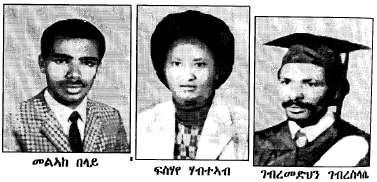
Compiled and researched by Resoum Kidane


In 1962 Ethiopia finally annexed Eritrea, thereafter the progress of education started to go into reverse as educators became the target of repression, incarceration and torture in the late 1950s. The situation became extremely hostile for any kind of open youth activism inside Eritrea during the 30 years of Ethiopian occupation, Prior to annexation, even though the Ethiopia government tried to hamper the development of education, during academic year 1961/62, the total number of students reached 38,000 of which 1,372 were in academic high schools and vocational institutions (see Statistical Abstract, Addis Ababa, 1963) p.106.,
The May 1962 student demonstrations and the 7 July 1962 attack on government officials in Agordat were important political events of the year. These two incidents might even have contributed in hastening Ethiopia's decision to dissolve the Federation on 14 November 1962. After the annexation, the suppression served the Eritrean cause by breeding more anti-Ethiopian sentiments.
Kidane, Eyob (2002) states that after the annexation of Eritrea in 1962 and the formation of ELF in September 1961, the Haile Selassie regime with its scorched earth policy and mass killings in the Easter and Western Eritrean lowlands burnt villages including schools and some schools were turned into military camps. Tens of thousands of Eritrean people including students and teachers were uprooted from their villages and towns and forced to flee and seek refuge in the Sudan.
Furthermore, in 1963, the elementary and secondary teachers were unhappy at the Ethiopian government's policies and were active in clandestine nationalist organizations. As a consequence, many of them were arrested, jailed without trail, or transferred to Ethiopia by 1963 an estimated 3, 000 Eritrean civilians were in prison on suspicious of sympathizing with the ELF [Gottesman p82].
In the 1960s and 1970s, the Ethiopian government intensified its crimes against the Eritrean people; those crimes were mentioned by various authors, journalists and human rights activist. For example, between February 11 and April 1967, Government troops killed some 402 civilians in Barka. Some 21 Eritreans, including teachers and government employees, were executed in Tessenei prison on February 12, 1967.
Ras Asrate Kassa governor of Eritrea took a more conciliatory line to teachers and students who showed no overt dissent but hundreds of students were arrested following the three day strike of secondary -school students in Asmera in March 1965.
In December 1970, Emperor Haile Selassie appoints General Debebe Haile Mariam military governor replacing the civilian Ras Asrat Kassa. The same year Emperor Haile Selassie declared a state of emergency throughout the Eritrea province.[2] Thereafter students, teachers and other educated groups became more the target of the government.
Tsega Gaim in her interview with Tanja R Muller states that in 1970s, the Ethiopian regime was arresting different students from her school and other schools. She recalls that in 1973 she didn’t go to school, schools were closed, and she and her classmates lost an entire year of study. However later in 1974 when the Emperor was overthrown and replaced, for brief period, by General Aman Andom, as head of the state, the situation started to improve.
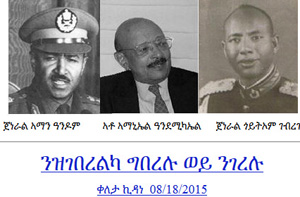
Habte Teclemariam wrote These are three interesting personalities who had a role to play on the life of the Eritrean people long , long time ago. Ato Amanuel was the Governor General of Eritrea during the time of Weki Zagr meetings. General Goitom was the Police Commissioner and General Aman was the Chairman of the Derg. All three personalities were of Eritrean origin. General Goitom was trying to direct the traffic so the Eritreans could travel to Weki/ Zagr to mediate and visit between the Eplf and the Elf. The Ethiopian Army was about to use tanks and Army personnel to punish those who had made the trip to Weki/ Zagr on their way back to Asmara. General Goitom argued with the Army, that the issue was a police matter and that he wanted to try to resolve the issue peacefully. The Army insisted that it was taking place in an area that was declared in a stste of emergency. So Goitom complained to the Governor General, an excessively intelligent jurist, thay he could not resolve the matter without intervention from the Chairman of the Derg, General Aman Michael Andom. After a telephone conversation, General Aman made it to Asmara in an Air Force trining Jet, that made the trip in less than 20 minutes from Debre Zeit (Bishoftu). He was enraged against the Army commanders for their erratic position and made a determination that the Police will be handling the issue until everyone who had made the trip had returned back safely to Asmara. Consequently, the residents of Asmara who had never heard of General Aman started having second thoughts about the Army's and Dergue's actions during that time. There would have been a bllodbath. But General Aman saved the day with help from General Goitom and Ato Amanuel Andemicael. Ato Amanuel was a world respected jurist, for I saw one day Senator Robert Kennedy vvisiting Asmara on his way back from laying the foundations of the Kennedy Library in Addis Ababa and also back from a trip to South Africa. I heard Senator Kennedy call Ato Amanuel by his first name because they had been classmates at Harvard Law School. At that time Ato Amanuel was the Attorney General of Eritrea before he was prompted to the same position for the whole country in Addis Ababa by the Late emperor. This is a history making picture and should not be skipped easily.
General Aman Andom’s attitude towards the solution of the Eritrea problem. Excerpt from General Aman Andom’s Role Discussed with Former Ethiopian PM Fikre Selassie
The policy to be adopted towards the Eritrean Liberation Front (ELF); and over the punishment of the numerous aristocrats and former government officials in the Derg's custody [verb missing]. Moreover, the Derg wanted the army from Harer to move to Eritrea and the army that was in Eritrea to move to Harer. He said, if the army from Hare moved to Eritrea, they will be too brutal to the people. The Derg said the army in Eritrea will not fight because they were too integrated with the people. His refusal to sanction the execution of former high officials, including two former prime ministers and several royal family members and relatives, put his relations with the majority of the Derg on an especially bitter footing. As an Eritrean, General Aman found himself fiercely at odds with the majority of the Derg. He wanted to negotiate a peaceful settlement; his opponents hoped to crush the ELF by military force. Aman went as far as making two personal visits to Eritrea—the first 25 August to 6 September, the second in November—giving speeches in which he stated that the end of the Imperial regime was also the end of the old practices towards Eritrea and that a government dedicated to national unity and progress would restore peace and prosperity to Eritrea. He promised that he would begin investigations concerning crimes that the army had perpetrated on Eritreans and punish the guilty.[3][SOURCE General Aman Andom’s Role Discussed with Former Ethiopian PM Fikre Selassie
However after the assassination of Aman Andom, the circumstance of the Eritrean youth and educators got worse. This was exacerbated when a number of Eritrean students at Asmara University boycotted the Zemetcha in late 1974 (Campaign for National Development through Cooperation)
The situation deteriorated still further, on February 15, 1975, when fierce fighting began in areas surrounding Asmara. The Ethiopian government declared martial law in Eritrea. Many students were massacred, mass imprisonment, detention and main roads were blocked. Some were forced to serve in the military and others left their towns either to join the liberation fronts or to live as refugees in other part of the world (Rena (2005))
According to Human Rights Watch in 1975, there was a great deal of violation of academic freedom at the University of Asmara, which included the killing of Dr. Petros Habtemikael, Dr Berhe and of others. Consequently, between 1974 and 1976 the number of Asmara University students declined to 349.
Dr Berhe graduated from the program and continued studies where he graduated with a doctorate in Law and used to teach criminal law at the University of Asmara. Needless to say he was Attorney General of Eritrea at the time he was murdered[source taken from Habte Teclemariam' comment wrote on Amanuel Haile facebook https://www.facebook.com/photo.php?fbid=10208145352174689&set=gm.1326096100798698&type=3&theater

Dr. Berhe (Berhe Ingilize ) is from back row third person.Laws and customary Norms Asmara 1962. The above photographed group was researching oral tradition, laws and customary norms of indigenous population of Eritrea. This codification of the laws and customary norms was a long process, which involved numerous assemblies of elders, representing local leading families and ethnic subgroups. The laws were not codified but left as manuscript by the group but they gathered important historical oral tradition, laws and customary norms references. source Amanuel Haile facebook https://www.facebook.com/photo.php?fbid=10208145352174689&set=gm.1326096100798698&type=3&theater
Dr. Petros Habtemikael
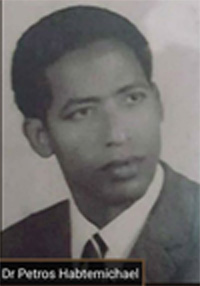
Dr. Petros Habtemikael, an economist, in 1975. Dr. Petros taught extension courses in the evening, and some of his students were Ethiopian military officers, who objected to his use of Eritrean rather than Ethiopian examples in his coursework, and to the low grades they were given. It is believed that the officers caused Dr. Petros to be detained and executed. Source Freedom of Expression and Ethnic Discrimination in the Educational System: Past and Future . Lemlem told Amrit Wilson. An Eritrean lecturer. Dr. Petros, saidbin his lecture Tigre was the oldest, then Tigrinya, then Amharic. The Ethiopian students were angry about this they wanted to be told that Amharic was the oldest. At that time the soldiers on their own initiative constitued into a murder squad: they would kill people by electrocutting them with a wire round the neck. Dr. Petros was the first victim but many other people were also killed[Wilson 71-72 page
Here is more information related to the killing of Dr. Petros Habtemikael from the book of Dabasu Ababa-Man yengar, zenabra p.125
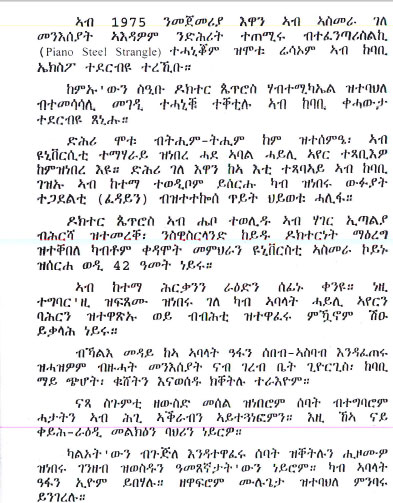
Excrept from Long way from Adi Ghehad a biography of Dr Teame Mebrahtu, Chapter 20 University and the Death of a Friend
Dr Petros was an old friend of Teame's whom he had first met at the student conference in Bologna during his time at Beriut in 1964. Petros had joined Teame in distributing propaganda protesting at the annexation of Eritrea by Ethiopia whilst attending the conference of student leders in Bologna in Italy. At that time Dr Petros represented Switzerland, while Teame was representing the Middle East.
Teama joined the University of Asmara in late 1974, the particular problem that Teame encountered soon after he joined the University was the decision by the Dergue to implement a policy of sending students out into the village to work on the land with farmers harvesting and maintaining crops. It was not popular with the Asmara University students-99% of them Eritrean who already opposed to the Mengistu regime.
Teama found himself pulled into the controversial new policy when the President of the University, Dr Assefa Tekle, a former head of the Pasteur Institute in Addis Ababa, received a letter from the regime ordering him to implement the new policy.
Dr Tekle asked Teama and another Professor, Dr Petros Habtemichael, to take on the responsibility of telling the students what was asked of them and to report back to him.
Teama was not not comfortable with the idea, But he and Dr Petros had no option but to comply with the request from the University President.
The two of them called a meeting of the students in the university auditorium. There were angry protests when the plan was outlined. Teame wrote a report to the university Presedent explaning what they had done and the reaction of the students.
Teame had taught an Ethiopian military officer in one of his classes and had no problems with him. But Dr Petros, who taught him in his economics class, got into constant arguments with him---particularly when he expounded his view that Eritrea could be self-sufficient economically. The country had, he said, copper and gold as well as petroleum in the Red Sea. He was giving an honest opinion (which history has since proved to have some substance). But it was dangerous politically. It went against the Ethiopian view that Eritrea could not survive on its own and needed Ethiopian support.
The Ethiopian officer would angrily confront Dr. Petros. They would have fierce arguments with Dr Petros challenging the Ethiopian propaganda of the time which also claimed that Eritrea got its cereals from Ethiopia. Dr Petros put forward the view that, with the right resources and support, Eritrea could be the bread basket of East Africa. read more
Dr Father Augustino Tedla

ኣባ ኣጎስቲኖ ንኣዲስ ኣበባ ተወሲዶም ዳርጋ ንሾውዓተ ዓመት ኣብ ቤትማእሰርቲ“ ኣለም በቃኝ” ተቐጥቂጦም ኣይምዉት ኣይጥዑይ ኮይኖም ተፈትሑ ድሕሪ ምፍትሖም ኣብ ዓዲ ጥልያን እንዳተሓከሙ ከኣ እታ ክብርቲ ሂወቶም ንሃገሮምን ንህዝቦም ንዘይርሳዕ ፍቕሪን ታሪኽን ገዲፋ ሓለፈት። source http://emnetu.com
Gottesman(p83) states that during the Derg’s rule educated Eritreans and youth were a particular target of harassment and violence etc. Thousands were detained and many met horrible deaths. Dozens of young Eritrean students were strangled with piano wire by the Ethiopian security service in the late 1970s
Although in the late 1960s the university of Asmara also showed good progress in the enrolment of students, in 1975, in this climate of vilonce, the number of Asmara University students declined from more that 1,500 to 349 and still further during the Red Terror between 1977 and 1978.
Saba Asier also recounted her experiences in her eleven months of imprisonment: “I was arrested in 1982 on suspicious of being an EPLF member. I was imprisoned in Mariam Gumbi, for each arrested person there are seven to eight interrogators. They tie your big toes and your hands together, your arms round your legs. Then they put a stick under your knees; this is called the number 8 because your body is in the shape of an eight. They make a ball from the clothes and vomit of prisoners and put it in your mouth. They turn you upside down and then they start beating the bottom of your feet. You hang from the stick which they lay with its end on two tables. Seven or eight people take turns beating you. When one gets tired, another takes over. On the first night they beat me all night from 5.30 pm to 4 o'clock the next morning. They wanted the names of my friends before they could flee from their homes as soon as the curfew was lifted at 6 in the morning. The second day at 8.30 in the morning they called me again. They beat me from 8.30 till 12 0'clock. One hour of number 8 and then number 9. In number 9 my big toes were tied together and while I was lying on my belly they stood at the sides of my head and pulled my toes over my back. One man stands on your back. Your hands are tied; they hit your feet with stick made of leather. As they beat you their hands turn red and sometimes start bleeding. So you can imagine if it hurts them that much, how much it hurts the person that is being tortured “
As a result of massacres, mass imprisonment and detention not only the number of schools and students declined dramatically but also, the number of Eritrean teachers in Eritrean schools fell from 3,000 to 1,200 as many of them joined the EPLF and ELF or went in to exile. (Africa Watch ,1993) Tsega Gaimin a teacher who graduated from Asmara Teachers Training Institution (TTI) in 1975 and then joined the EPLF states in her interview with Tanja R that ‘out of around 500 students at TTI, I think we were only 16 Eritreans’.
Excrept Long wayfrom Adi Ghehad a biography of Dr Teame Mebrahtu, Chapter 12, Teachers Training Institution.
Teachers Training Institution (TTI) was highly regarded as one of the best teacher traning centres in the whole of Ethiopia. The majority of the students were Ethiopian, far outnumbering the Eritreans. There was an uneasiness between the two. Amharic was now the official language. The Ethiopians considered themselves superior to the Eritreans. Books in Tigrigna had been burnt after annextion much to the dismay of Teame and his fellow Eritreans. When Teane was awarded his BAi] in Arts and Sciences at the end of his study at Beriut, he was assigned at the Teachers Training Institution (TTI). During this time the director was an Ethiopian, Ato Matewos Gessesse, who had a Master's degree from an American university. Since annexation in 1962 it had been the policy to put Ethiopians in position of authority throughout Eritrea. Under the Eritrean Parliament they had their own Ministers. Now Ethiopians were al all the top posts. It caused resentment among Eritrean professionals like Teame, who considered themselves well able to run things themselves. [pages 96-98 source Long way from Adi Ghehad a biography of Dr Teame Mebrahtu, 2017.]
Martyr Berhane Tesfamariam (wedi Balilla)

Berhane was arrested and killed 1 month after his arrest on July 1978. At that time Mariam Gimbi did not exist. They were taken to Enda Afras and then Sembel. Either for court (Chelot) or execution. readmore
During the Red Terror of 1977-78 teachers and students were executed. Among the teachers and educationalists executed were:
* Tesfameskel Sebhat-Leab, Asmara;
* Stefanos Teklai, Asmara;
* Tzerai Bokratsion, Asmara;
* Hassen Nur Hussein, Deputy Personnel Administrator, Asmara;
* Mengistu Sebhatu, Adi Qeyih.
In 1979, twelve teachers were detained on suspicion of collaborating with the EPLF, and some of them were subsequently executed. Among the killed was the leader of the Teachers' Association. According to the EPLF and other sources, the arrests were made on information supplied to the security forces by Hassen Obeid, a half-Yemeni former schoolteacher and reformed alcoholic, who joined the Workers' Party of Ethiopia (WPE) and the National Tourist Organization, and also worked as a security informer. Hassen was also a part-time teacher of English at Asmara University. Following a trial in absentia by the EPLF, Hassen was assassinated by an EPLF squad for his alleged crimes on January 10, 1991. read more


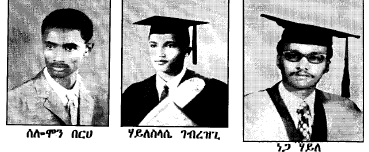
In 1980 a women teacher named Mebrat was executed with other 10 teachers, Memhir Tuku her husband who joined the EPLF in 1970s herad this tragic news over the radio. Regarding the execution of this women teacher, Ararat Iyob descibed in the following :....."a teacher named Zerai (I do not remember his father’s name) asked questions. Sometime later Zerai was picked up by the security, and a few weeks later, he and about 10 teachers, one of them a woman, were executed and the news was sent over the radio. The „goat song “(yefiel wetete) was sung during the announcement the most notorious political prision.
Under the Derg, largely resulting from human rights violations and the abuse of academic freedom the number of Eritrean professionals, students and schools declined still further between 1974 and 1991
Donatella Lorch (1993) states that the Marxists who took over the Addis Ababa government in the 1970's discriminated against residents of Eritrea in the university's admissions policy. More than 70 percent of its teachers and 90 percent of its students were Ethiopian. Then in July 1990, with Asmara under siege by the front, the university was transferred to Agarfa, south of Addis Ababa. After a semester, it closed and the students were drafted into the military.
The 30 years conflicts and human rights abuses committed by the Ethiopian rulers also considerable contributed for hindrance the progress of education and high brain drain rates.

For three decade Eritrea had experienced a brain drain, based on this graph 45 % of emigrants from Eritrea had university education.
ehrea.org © 2004-2017. Contact: rkidane@talk21.com | ||||